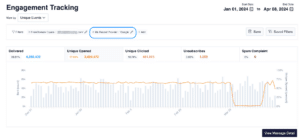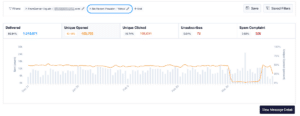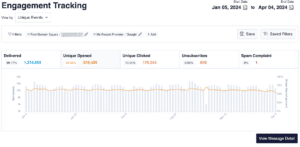Every email marketer wants their messages to arrive in the inbox and not the spam folder. So when Gmail and Yahoo announced they’d be enforcing new sender guidelines that deeply affect deliverability for anyone sending to their addresses, every email marketer’s ears perked up. Hence why we hosted a virtual Litmus Talks with experts from Yahoo, Braze, and SocketLabs to weigh in on how best to navigate these requirements.
Don’t have time to watch a virtual event? Here are some of the key takeaways:
- What the new sender requirements are
- How the new sender requirements impact deliverability
- Which steps to take technically and strategically
- How to frame these adjustments for internal stakeholders
With that, let’s dig into the details…
What are the new Yahoo and Gmail sender requirements?
To begin, let’s briefly recap what these requirements entail. If you’re a bulk sender—which Google defines as anyone sending 5,000 or more emails in a day—you must:
- Verify your sender identity by authenticating using DKIM, DMARC and SPF records
- Implement list-unsubscribe headers and honor opt-out requests within two days
- Maintain a spam complaint rate below 0.3% (no more than three spam reports for every 1,000 messages)
The first thing to note about these “new” requirements is that they aren’t actually new—these standards have existed for years, but have not been enforced. The only change now is that Gmail and Yahoo are enforcing them due to steadily increasing spam.
How do the new sender requirements impact deliverability?
Functionally, what it will look like when they are enforced is no different in effect than what it looks like currently. Non-compliant senders may have their messages deferred (where delivery is delayed) or blocked, or routed to spam depending on the sender reputation, among other factors. Initially, if you aren’t compliant, you’ll likely see a spike in deferrals before you see blocks or bounces.
You can already see how the new requirements are impacting brands in the wild.
Lauren Meyer, CMO at SocketLabs, shared with us how impactful the new Yahoo and Gmail sender requirements are and the importance of being fully compliant.
The customer has 3 sending domains: two that were authenticated and fully compliant with Yahoo and Gmail—and then a third domain which was not authenticated.
Here’s the view of email opens on the non-compliant domains, first Gmail:

And now from Yahoo:

Compare those to the fully compliant sender:

The data tells a compelling story. For the non-compliant domain, email opens dropped off as soon as Yahoo and Gmail started enforcing the new sender requirements. Thankfully, once the customer became compliant things returned to form.
The simple math here is that it’s paramount for all email teams to take up the practice of getting and remaining compliant.
Something that all of our guest experts made a point of noting is that even if you think you fall beneath that 5,000 messages mark, it’s still in your best interest to adhere to these guidelines as best practices that will serve you well now and as your list grows.
The last bit here is that these requirements will—while certainly taking extra effort—undoubtedly make for a better sender experience overall. As our guest Alison Gootee (Braze) put it succinctly, “Less competition with crap in the inbox means that people are going to see your stuff sooner, better, and more accurately.”
How to technically and strategically prepare for the sender requirements
When it comes to identifying which steps to take to make sure you’re following these guidelines, there are two ways of looking at them. You could just look at the requirements as a technical checklist, and certainly, you do want to make sure you are taking each of these steps:
- Use a tool like Litmus Spam Filter Testing to determine whether you have SPF records, DKIM and DMARC set up (and use the contextual links provided to take action if you do not)
- Check with your email service provider (ESP) to see if they are automatically adding a list-unsubscribe header to your emails or if you’ll need to add it yourself
- Use a tool like Google Postmaster to check your spam compliance rating (Yahoo has its SenderHub, which is currently in beta) to see where you are currently
However, there are plenty of spammers who know how to follow those technical steps, who know to authenticate, etc. Following these steps alone is not enough on its own, which is why you also need to look at how and what you send from a strategic standpoint.
Sending emails that are relevant and valuable to your subscribers is central to effective email marketing, because if you are not, you can be authenticated and include a list-unsubscribe header and still be marked as spam. The bigger question to ask here is, are you sending messages that your subscribers want to receive?
You can help answer that question by keeping a close eye on your engagement metrics. Click-through rates are a great measure of relevance and interest, for example. Bounce rates can tell you if you need to take a closer look at the validity of email addresses on your list. And always make sure to honor unsubscribes as quickly as possible (if they aren’t automatically handled through your ESP).
How to talk to internal stakeholders about the requirements
Finally, it’s likely that some of the steps you might need to take to adhere to the Gmail and Yahoo guidelines will need buy-in from managers or directors who may not be as familiar with the details of email marketing as you are. Let’s talk about how you might frame the necessity for these changes for internal stakeholders.
Step 1: Skip the acronyms
First, you don’t need to use all the acronyms—DKIM, DMARC, etc. Simply explaining that Gmail and Yahoo are requiring three specific forms of sender identity validation should be enough to make your point. Having to present multiple forms of identification is a concept that is already familiar for any adult, and that familiarity helps ease understanding.
Step 2: Educate on spam complaint rate
Second, when talking about the spam complaint rate, .03% doesn’t translate as easily as saying, “We can’t receive more than three spam complaints for every 1,000 messages we send.” Putting it in plain language that really highlights how few spam complaints you can afford to receive.
This also helps make the case for steps you need to take to avoid spam complaints, such as:
- Implementing email monitoring to assure your emails aren’t arriving broken in the inbox
- Prioritizing list hygiene to make sure the addresses you are sending to are valid
- Evaluating the types of emails you are sending to your subscribers
Step 3: Be direct about repercussions
Third, be clear about the consequences. If you receive more than three spam complaints per thousand messages, or fail to implement the other technical steps, your emails will be at very least deferred in being delivered. Make note of the potential negative effect of time-sensitive emails being delayed like sales alerts, event notifications or product launches. If your emails start being blocked or routed to spam, connect that directly to the impact on revenue, lead acquisition or whatever other key performance indicators your email program drives.
Comprehension, preparation, and communication are key
Though these Gmail and Yahoo sender requirements may seem like a huge change from how much attention they are getting, you don’t need to panic. Just take a deep breath and remember these things:
- These requirements aren’t new, they’re just finally being enforced because of increased spam
- Setting up DMARC, DKIM, SPF records and list-unsubscribe headers helps maintain and deepen subscriber trust, and are good for everyone
- Following the technical steps alone isn’t enough to keep you out of the spam folder—you also need to make sure the emails you are sending are relevant to and desired by your subscribers
- Use plain language and connect consequences directly to key performance indicators (KPIs) when framing needed changes to your email program for internal stakeholders
Keep these points in mind and you’ll be in good shape to safely navigate the changes.
We’ve got your back
If you didn’t already know, Litmus has a feature, Email Spam Testing, that allows you to test your message against common spam filters, help you discover if you’ve been blocklisted, and validate your authentication through DKIM, DMARC and SPF records. In your quest to stay below that .03% spam complaint rate, Email Spam Testing can help offer peace of mind.
The post How to Navigate New Sender Requirements from Gmail and Yahoo appeared first on Litmus.
https://www.litmus.com/blog/how-to-navigate-new-sender-requirements-from-gmail-and-yahoo
